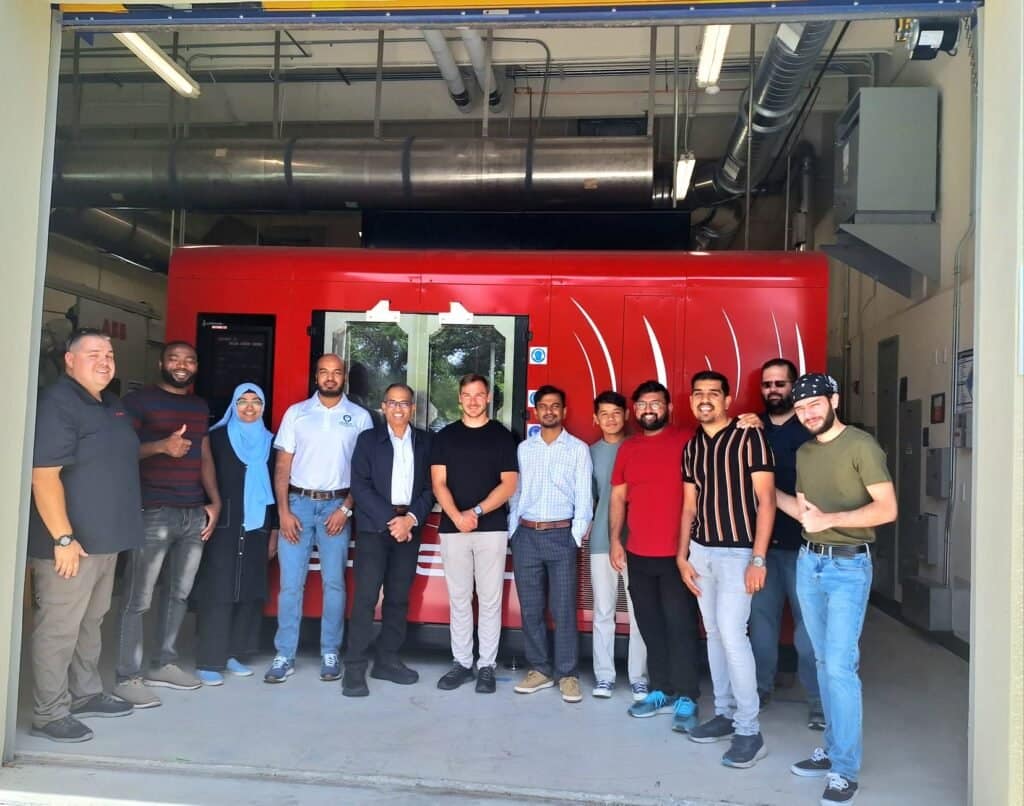In today’s 3D Printing News Briefs, Florida International University acquired a WarpSPEE3D printer from SPEE3D for rapid production of large-scale metal parts. QuickParts announced an extension to its 3D printing service that’s focused on injection molding. Two very different kinds of warnings were issued about 3D printing in the UK. Finally, researchers in Seoul have developed 3D printed carbon nanotube sensors for smart health monitoring.
FIU Acquires WarpSPEE3D for Large-Scale CSAM Application Research

(Left to right) SPEE3D technician Alex Yingst stands with FIU team celebrating new WarpSPEE3D printer addition in the ColRAD Lab. (Image credit: Florida International University)
Aussie metal AM equipment OEM SPEE3D announced that Florida International University (FIU) has acquired a WarpSPEE3D system to use in its Cold Spray and Rapid Deposition (ColRAD) Laboratory. The WarpSPEE3D uses the company’s proprietary cold spray additive manufacturing (CSAM) technology, which fabricates high-density metal parts by depositing feedstock particles at supersonic speeds to build components that weigh up to 90 lbs that have excellent metallurgical properties. FIU plans to put the printer to good use in advancing material science research for large-scale CSAM applications. Researchers at the ColRAD Laboratory will explore the full potential of SPEE3D’s CSAM technology, focusing on areas like benchmarking cold spray metallurgical properties against traditionally manufactured parts, the correlations between processing parameters and the structural behavior of 3D printed metallic parts, and robotic path development for large-scale, complex geometries.
“At FIU’s ColRAD laboratory at the Department of Mechanical and Materials Engineering, our focus is on using cold spray additive manufacturing to investigate process-structure relationships, optimize robotic path development for large components, and evaluate material performance against traditional techniques,” explained Dr. Tanaji Paul, Assistant Professor at Florida International University. “We look forward to seeing how SPEE3D’s technology will enhance our ongoing research in metal and composite additive manufacturing.”
Quickparts Introduces Quick Mould Service for Rapid Tooling
Quickparts, which celebrates its 35th anniversary this year as a trusted manufacturing partner, recently announced the launch of a new rapid tooling solution called Quick Mould. While this new service is for speeding up the injection molding process, it is an extension of the company’s existing 3D printing services. Meant to make product development faster and improve flexibility for customers in Europe, Quick Mould enables engineers and designers to move more quickly and seamlessly from concepts to functional, production-grade parts. The service combines high-performance thermoplastics with rapidly machined aluminum molds, so customers can validate their parts’ performance, stay on schedule even with design changes, and reduce the delays typically found with traditional tooling; Quickparts says its new offering can actually deliver five-day turnarounds across Europe. Available to customers across the EMEA region, Quick Mould production takes place locally at the company’s European center of excellence in Pinerolo, Italy.
“Quickparts was founded on the promise of Limitless Manufacturing, delivering high-quality parts without compromise on complexity, volume, or speed. Quick Mould brings that philosophy to life, offering engineers a responsive, dependable solution to accelerate development, adapt to changes, and stay ahead of tight market deadlines,” said Peter Jacobsen, EMEA President of Quickparts.
Additive Manufacturing UK Leader Warns MOD Not to Ignore 3D Printing
A few months ago, the UK Ministry of Defence (MOD) unveiled its Defence Advanced Manufacturing Strategy, which stated that the use of additive manufacturing would be increased for defense applications “to realise its potential benefits.” Some time after the strategy was announced, AMufacture CEO Craig Pyser, the chairman of trade association Additive Manufacturing UK (AMUK), said that the sector is too unfamiliar with modern AM applications, and that it could miss out on millions in savings by not further capitalizing on the technology. Pyser’s company, co-founded by former naval architect and Olympic sailor Will Howden, has invested heavily in HP’s Multi Jet Fusion technology for applications in the automotive, medical, aerospace, and marine industries, so he knows what he’s talking about when it comes to AM. He says that the UK defense sector needs further education about what AM can offer so as not to block access to vital production-ready capabilities, noting that there “is a real wealth of 3D printing talent in the UK” just waiting to be tapped…especially as the MOD is “managing an inventory that currently exceeds 1.3 million items.”
“The MoD’s own strategy references a Defence Innovation Unit report estimating that if 15% of the defence inventory were additively manufactured, the net financial benefit to the MOD would be £110m over the next 15 years,” Pyser said.
“There are also ongoing annual benefits of £35.5m but those figures will only materialise if we bridge a critical knowledge gap between our industry and procurement teams commissioning large scale defence contracts.
“The technology exists and, importantly, the companies exist. We have UK firms delivering production-scale additive manufacturing right now, but there’s a fundamental knowledge gap preventing the sector from maximising these capabilities. Education is vital and we all have a role to play in shaping the conversation.”
Warning Issued in Lincolnshire on Sales of 3D Printed Products
Lincolnshire County Council Trading Standards have warned businesses and residents across Lincolnshire, a ceremonial county in the East Midlands and Yorkshire and the Humber regions of England, to make sure that 3D printed products meet safety regulations, and are properly labeled. The county has been seeing an increasing amount of non-compliant 3D printed products sold via online marketplaces, many of which are classed as toys. To ensure that the products are safe and not a choking hazard for children, these must comply with the relevant standards. If you’re selling these products, the law dictates that you have to display some important information, including the manufacturer or importer’s GB name and address; a product identifier, type, batch, serial, or model number; and the CE and/or UKCA mark. Anyone making or distributing 3D printed products can learn about their legal responsibility, and the necessary labeling, here for products classed as toys, or here if no product-specific legislation applies.
“With the increasing popularity of 3D printers, we’re seeing more products that don’t meet the important safety standards that are in place to protect people,” said Neil Bartlett, trading standards officer at Lincolnshire County Council.
“Trading Standards monitor online marketplaces and carry out regular inspections of products. Any that are found to be unsafe may be seized and destroyed and the printers behind them could also face legal consequences.
“It’s also worth noting that trademarked characters and logos by brands such as Disney are subject to intellectual property rights and should not be reproduced without the authority of the trademark holder.”
SeoulTech Researchers Develop 3D Printed CNT Sensors for Smart Health Monitoring

The proposed carbon nanotube-based nanocomposites facilitate 3D printing of highly stretchable and sensitive piezoresistive sensors that can be used to develop high performance, wearable health monitoring devices. Credit: SeoulTech
While 3D printing can be used to make electrically conductive polymer nanocomposites with integrated carbon nanotubes (CNTs), it’s not easy to achieve stretchability with maintaining conductivity, as CNTs make it difficult to obtain a uniform dispersion. This limits their use for applications like soft robotics, wearable devices, and flexible electronics. But a team of researchers from Seoul National University of Science and Technology (SeoulTech) in Korea has created highly stretchable CNT-nanocomposites, optimized for vat photopolymerization 3D printing. First, using ultrasonic waves for uniform dispersion, they dispersed multi-walled carbon nanotubes (MWCNTs) into an aliphatic urethane diacrylate (AUD) resin to prepare their polymer nanocomposite inks. After testing various 3D printed specimens made with this ink, the researchers used the CNT nanocomposite to print sensitive, flexible triply periodic minimal surface (TPMS)-based piezoresistive sensors. These were then used to develop a wearable smart-insole sensing platform for real-time foot pressure monitoring.
“The developed smart-insole device demonstrates the potential of our CNT nanocomposites for 3D printing the next generation of highly stretchable and conductive materials. We believe these materials will be indispensable for wearable health monitors, flexible electronics and smart textiles,” explained Associate Professor Soonjae Pyo from the SeoulTech Department of Mechanical System Design Engineering, one of the leaders of the research team.
You can learn more in their study here.




